AN immense treasure of finely crafted gold and gems found in a British field is casting new light on the squalid game of thrones which wracked Europe after the collapse of Rome.
Some 1300 years ago Europe was in turmoil. The remnants of the Roman Empire had retreated to Istanbul (then Constantinople) in Turkey. Plague and pestilence devastated the lands.
Disrupted Germanic tribes stormed through Britain to find new homes. Viking longboats pillaged the island’s shores. The native Britons — some still clinging to the remains of Roman towns and cities — were gradually rolled back towards the west.
But this tumultuous time spawned a multitude of myths. King Arthur. Roland. Beowulf.
At least, so the tale goes. It’s mostly because written records from this era are scarce that it was dubbed a ‘Dark Age’. Not because of any particular lack of skill or knowledge.
Now their long lost tale is starting to emerge, thanks to the Staffordshire Hoard.
For centuries the sagas and legends told of glittering warriors, sheathed from head to toe in gleaming gold. Many historians believed this to have been little more than poetic licence.
It turns out the old tales were true.
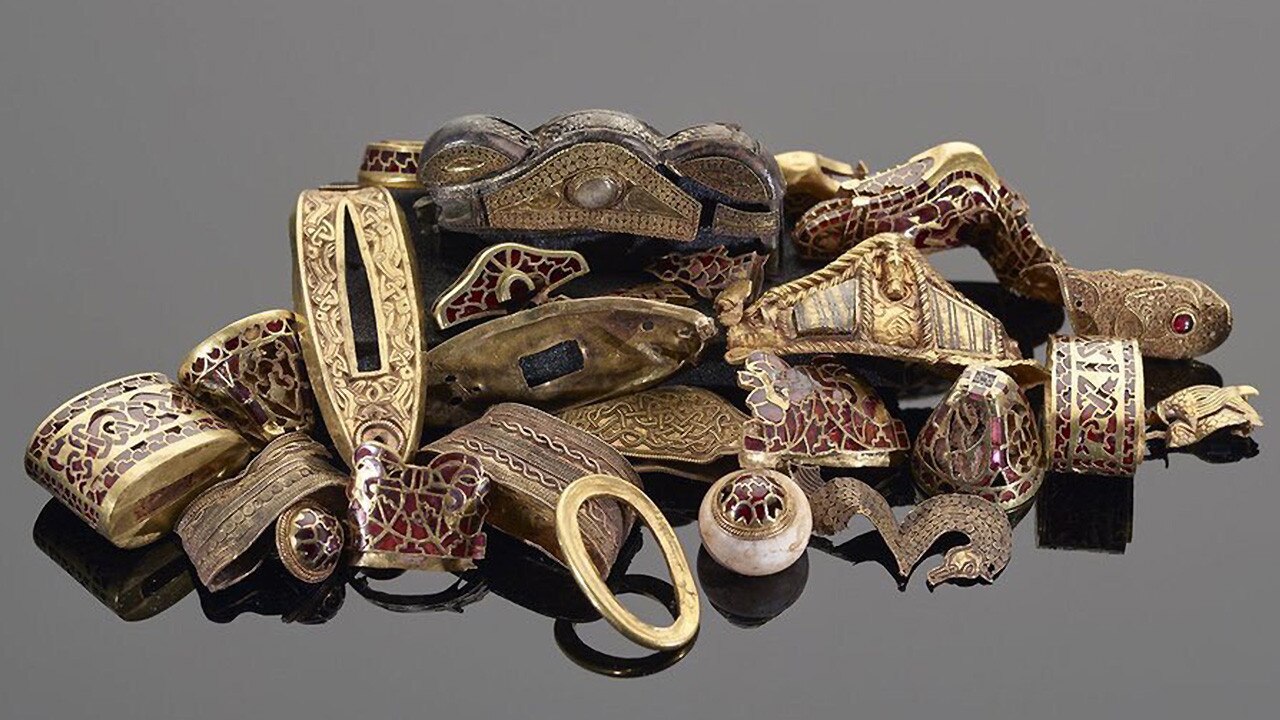
SECRETS IN THE SOIL
In 2009, an unemployed Staffordshire man bought an old metal detector for about $10. With it, he found a buried hoard of Anglo Saxon gold worth almost $A7 million.
In just a few days, he assembled more than 5kg of treasure from fields owned by a farmer friend.
Hundreds of soil-encrusted gold fragments were pulled out of the ground, all richly detailed with mythical animals and encrusted with jewels.
Many were ornaments wrenched from the arms and armour of noble warriors — and perhaps even an enormous processional cross.
“I can still remember the very first time I saw the hoard in 2010 — it was a few months after it had been discovered, and it was laid out so a number of experts could view it,” says Jenni Butterworth, the Staffordshire Hoard Programme Coordinator.
“The objects were still muddy and gathered together in bags and boxes. It was mind-boggling, the sheer number of items as much as the incredible craftsmanship and the gold and garnets.
Experts quickly dated them to between 675 and 725AD.
A second stash was recovered nearby in 2012. A further 500 pieces have also been found scattered through nearby fields.
All 4000 fragments have since been brought together, with conservationists carefully cleaning and cataloguing the fragments.
The pieces have slowly been put together.
Out of the carnage is emerging a picture of dazzling helmets, shining swords and breathtaking embellishments.
Every piece tells a tale.
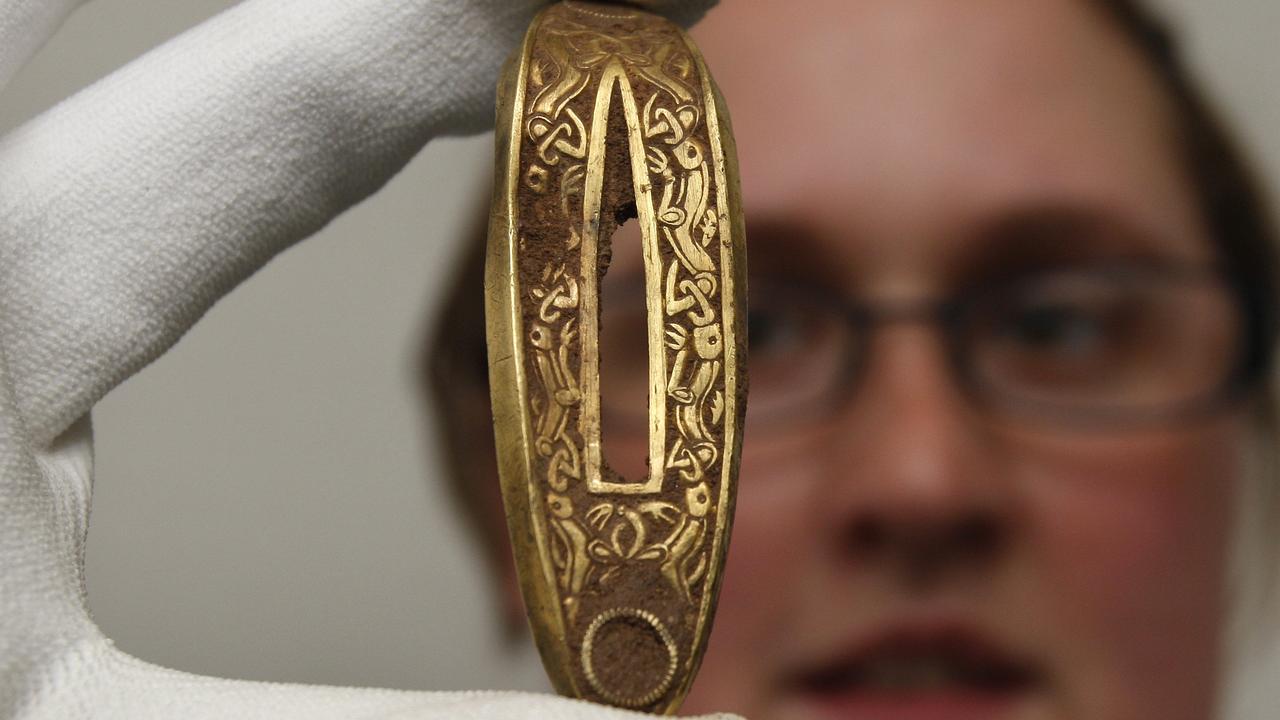
A TWIST IN THE TALE
The exceptional quality of this Anglo Saxon treasure has opened the world’s eyes to the true sophistication of the era’s artisans.
“You don’t have to be especially interested in swords to be awed by the hoard,” says the lead curator of the new Warrior Treasures exhibition, Henry Yallop.
“When considered as stand-alone art objects each hilt plate, pommel cap or sword pyramid is a breathtaking object, crafted from the finest of materials by the most skilled of hands. Yet these objects fitted together to be beautiful, yet crucial functional parts of weapons.”
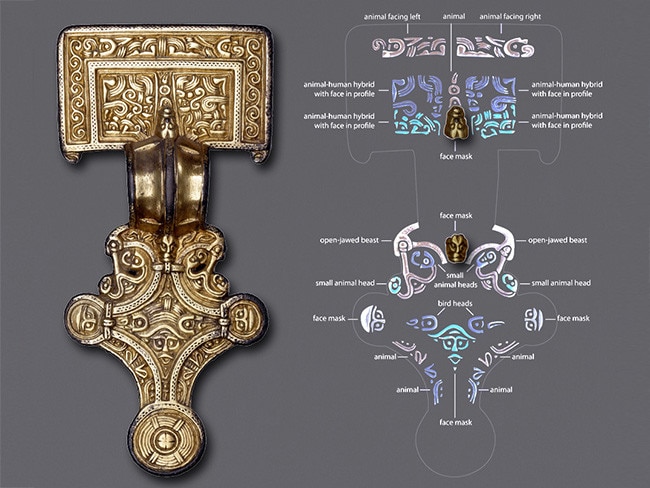
Sinuous gold thread, less than a millimetre thick, has been woven into tiny, florid patterns. Minuscule pieces of red and blue garnet have been carefully carved and set in elaborately decorated gold foil panels.
Amid the mass of lively, heavily stylised images are snakes, horses, wolves and warriors.
They represent a hidden language.
The artists intended viewers to spend hours puzzling over their patterns, finding new abstract creatures and faces embedded among the golden clouds of twists and curls.
It was, after all, an age of puzzles and riddles.
HORRIBLE HISTORY: The true tales behind Game of Thrones
But a practised eye would quickly be able to discern an entire tale woven through each decoration.
Historians believe the designs proclaimed the power of the natural world. Capturing their essence in an object was hoped to harness some of their strengths.
Different creatures conveyed different properties.
Snakes, for example, are believed to represent high status. In Anglo Saxon lore, they were believed to be shapeshifting creatures which demanded respect.
What tales the Staffordshire hoard contains are yet to be told. But now the fragments have been put back in their rightful places, and a new page on history is about to be opened.
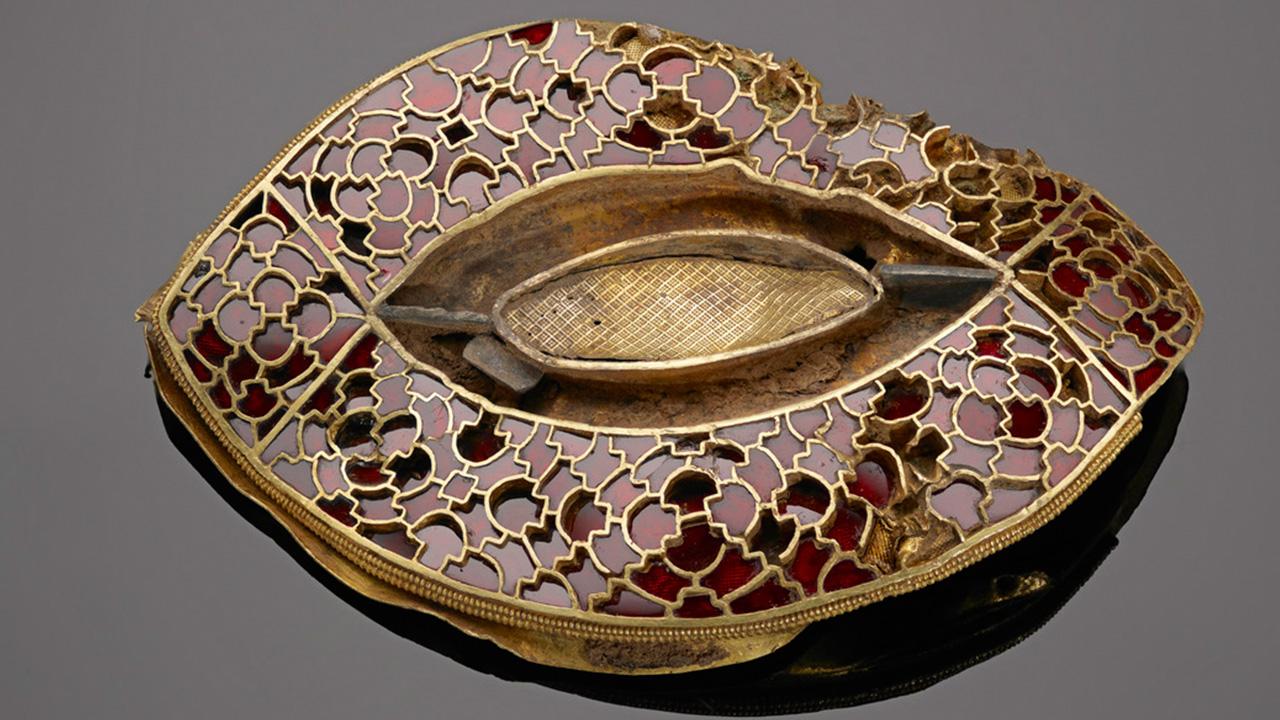
GOLDEN WARRIORS
The Staffordshire Hoard belongs to the era of the King Aethelred and the Anglo Saxon kingdom of Mercia, which covered much of modern day Yorkshire.
Exactly why the treasure, broken into pieces for easier transport, was buried remains a mystery. It was, however, found next to what was then a major highway — the Roman road known as Watling Street.
Had a major battle been fought and lost on that road?
The treasure itself appears to be loot stripped from the bodies of fallen warriors. At the time, King Aethelred was at war with the neighbouring kingdoms of Northumbria and East Anglia.
The simple fact the treasure had been buried and never recovered suggests the looters who assembled it had themselves been tracked down and killed.
More than 70 sword pommels (the ornate end to the handle) have now been recovered. Each is intricately — and individually — designed. All represent a startlingly high standard of workmanship.
“The great Anglo-Saxon poem Beowulf, once believed to be artistic exaggeration, now has a true mirror in archeology,” says specialist archaeologist Chris Fern.
“The skill of the craftsmen is thrilling to behold, with many of the finds decorated with pagan and Christian art, designed to give spiritual protection in battle.”
Experts say the hoard demonstrates that many Anglo Saxon warriors — usually drawn from the noble classes — went into battle with an immense wealth of weaponry and ‘bling’.
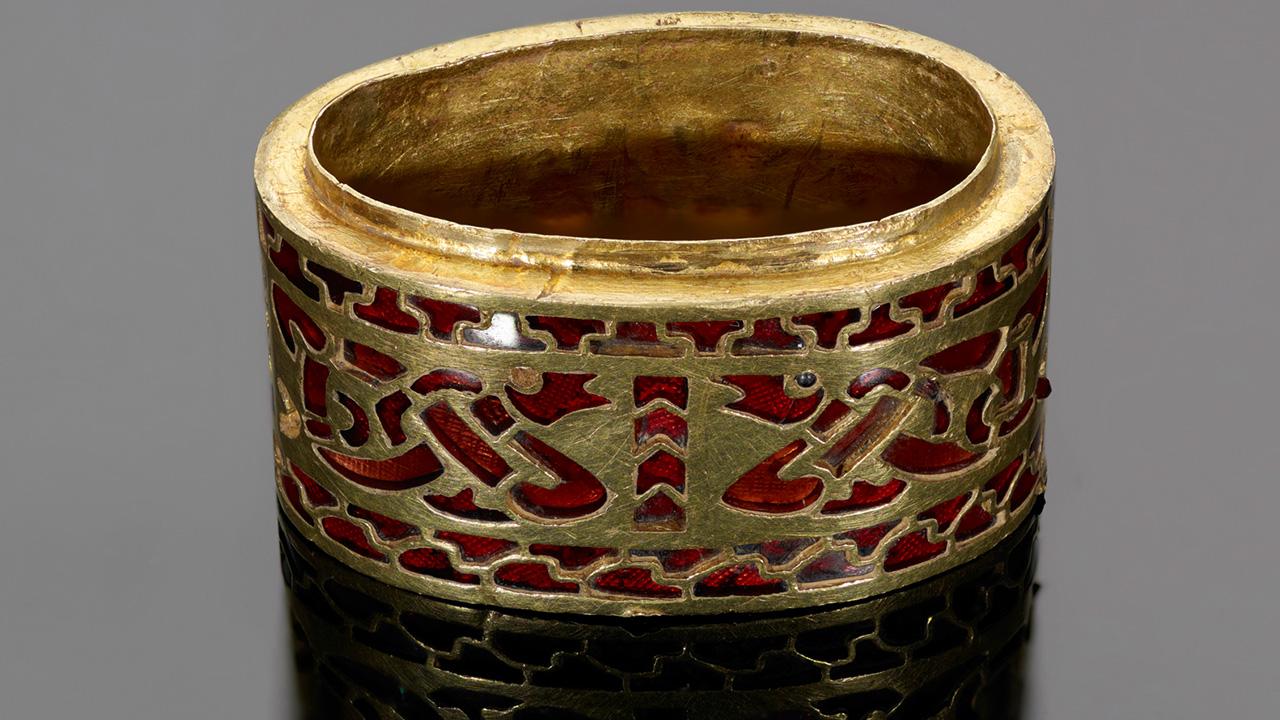
BLOOD IN THE GOLD
Such finely crafted weaponry represents a lavish investment of wealth, time and talent.
They became part of a family’s heritage. They signified a family’s status.
They were doubly important as they remained objects of practical use.
“Ornate, prized possessions of the elite these objects certain were, but it was a warrior elite who wore these weapons and used them in war,” Mr Yallop says.
Such swords, shields and armour were invested with almost spiritual significance. The legendary warrior Beowulf, for example, was honoured by the loan of a lord’s “rare and ancient sword named Hrunting” to defeat the monster Grendel’s mother.
And inheriting such weaponry was a major rite of passage in itself. The sword Excalibur, for example, conveyed the right to an entire realm upon King Arthur.
But, mostly, such elaborate swords and knives were bestowed as kingly gifts as a badge of honour for great achievements and acts of heroism.
“The gold and silver war-gear was probably made in workshops controlled by some of England’s earliest kings, to reward warriors that served those rulers, when multiple kingdoms fought for supremacy,” Fern says.
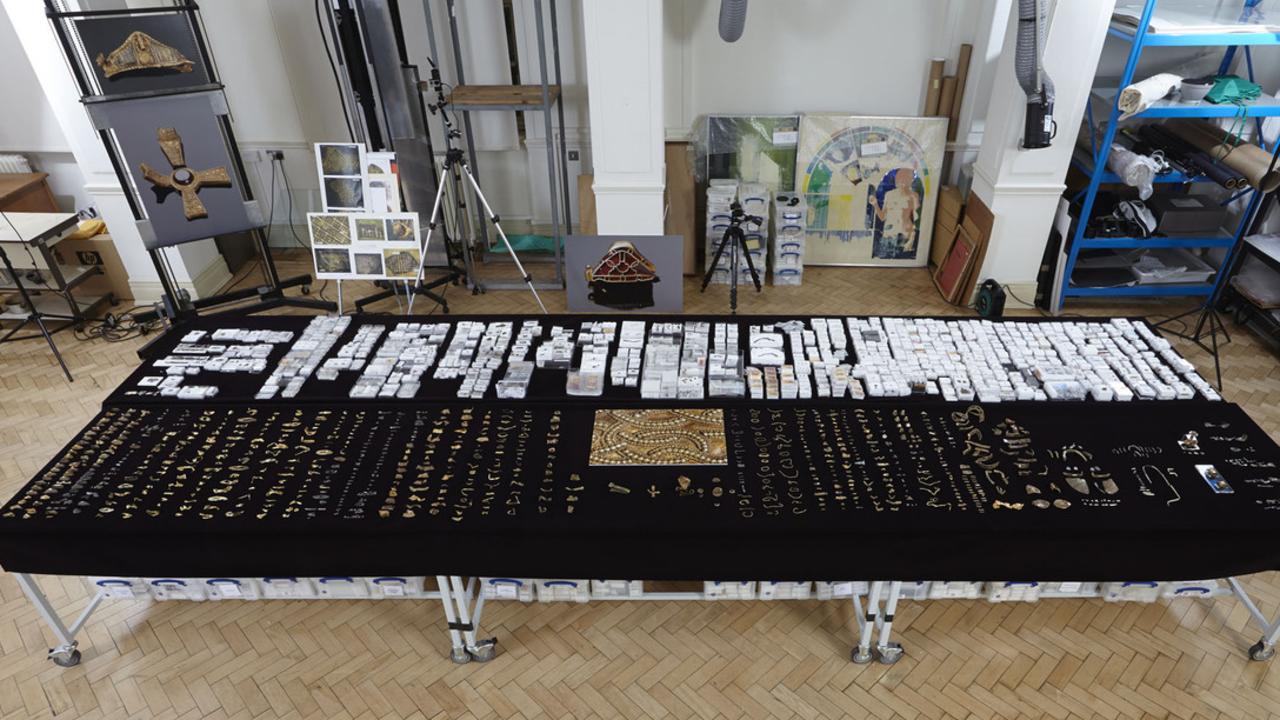
PRESERVING THE PAST
Cleaning and reassembling the treasure has proven to be no easy task.
As much of it is soft malleable gold, the danger of scratching and distorting surfaces is immense.
So experts turned to pulling thorns off bushes and affixing them to the end of scalpel handles. While sharp enough to pick dirt out from between the incredibly fine filigree, the thorns themselves bend before gouging the surface.
Ironically, the damage caused to the treasure as it was torn from its owners, and then divvied up by its Dark Age looters, is offering rare insight to the crafting techniques behind them.
Only when each piece is fully recorded and understood do the conservators attempt to straighten out some of the kinks and match them together.
The damage has also helped expose an ancient sleight of hand.
A MYTH IS BORN: The curse of the Templars
Dark Ages gold was usually an alloy, containing some 25 per cent to 50 per cent silver. But, somehow, the ancient goldsmiths ‘treated’ each object to remove the silver from the surface layer and give the object the glitter of pure gold.
Much of the ancient techniques, the preservation teams admit, remain a mystery. The craftsmanship behind the incredibly sophisticated spirals and linear patterns has long since been lost.
But it can once again be appreciated.
A new exhibition, named Warrior Treasures: Saxon Gold from the Staffordshire Hoard, opened this week in the Royal Armouries museum, Leeds. It goes until October 2.



Add your comment to this story
To join the conversation, please log in. Don't have an account? Register
Join the conversation, you are commenting as Logout
Here’s what you can expect with tomorrow’s Parramatta weather
As summer moves towards autumn what can locals expect tomorrow? We have the latest word from the Weather Bureau.
Here’s what you can expect with tomorrow’s Parramatta weather
As summer moves towards autumn what can locals expect tomorrow? We have the latest word from the Weather Bureau.